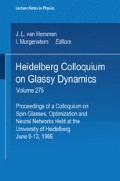Abstract
We study the way in which the properties of spin glasses and associative memory networks are changed when the interactions between the units are not symmetrical. Our models are analog networks subject to thermal noise (Langevin models). In an approximation which becomes exact in the limit of large spin dimensionality, we find that spin glass phases are suppressed, even for arbitrarily small asymmetry. However, in the associative networks, memory states are not seriously degraded; their critical temperature is simply lowered from its value in the corresponding symmetric model. The effect of making the number of memories a finite fraction of the number of units in the system is also qualitatively the same as in the symmetric case. We suggest that asymmetric couplings may make retrieval of the desired memory states faster, since the system will not get trapped in spin glass states.
Preview
Unable to display preview. Download preview PDF.
References
S Kirkpatrick and D Sherrington, Phys Rev B 17 4384 (1978)
J J Hopfield, Proc Nat Acad Sci USA 79 2554 (1982); 81 3088 (1984)
G Grinstein, C Jayaprakash and Y He, Phys Rev Lett 55 2527 (1985) (Conventionally, the term “cellular automaton” is taken to describe discrete-time systems, in which the updating sequence of the variables can obey various rules. Here we consider random sequential updating, which in the limit of a large system and for time resolution large compared to the updating interval is equivalent to a continuous-time formulation.)
C H Bennett and G Grinstein, Phys Rev Lett 55 657 (1985)
H Sompolinsky and A Zippelius, Phys Rev Lett 47 359 (1981); Phys Rev B 25 6860 (1982)
J A Hertz, J Phys C 16 1219, 1233 (1983)
S-K Ma, “Modern Theory of Critical Phenomena” (W A Benjamin, 1976), chapters 11–14
D J Amit, H Gutfreund and H Sompolinsky, Phys Rev A 32 1007 (1905)
D J Amit, H Gutfreund and H Sompolinsky, Phys Rev Lett 55 1530 (1985); and preprint, 1986
Author information
Authors and Affiliations
Editor information
Rights and permissions
Copyright information
© 1987 Springer-Verlag
About this paper
Cite this paper
Hertz, J.A., Grinstein, G., Solla, S.A. (1987). Irreversible spin glasses and neural networks. In: van Hemmen, J.L., Morgenstern, I. (eds) Heidelberg Colloquium on Glassy Dynamics. Lecture Notes in Physics, vol 275. Springer, Berlin, Heidelberg. https://doi.org/10.1007/BFb0057533
Download citation
DOI: https://doi.org/10.1007/BFb0057533
Published:
Publisher Name: Springer, Berlin, Heidelberg
Print ISBN: 978-3-540-17777-7
Online ISBN: 978-3-540-47819-5
eBook Packages: Springer Book Archive

